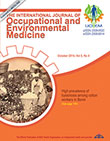فهرست مطالب

International Journal of Occupational and Environmental Medicine
Volume:5 Issue: 4, Oct 2014
- تاریخ انتشار: 1393/12/25
- تعداد عناوین: 10
-
-
Pages 175-186BackgroundThere is a significant proportion of workers with mental disorders who either are struggling at work or who are trying to return to work from a disability leave.ObjectiveUsing a population-based survey of working adults in Ontario, Canada, this paper examines the perceptions of workers towards mental disorders in the workplace.MethodsData are from a sample of 2219 working adults identified through random digit dialing who either completed a telephone questionnaire administered by professional interviewers or a web-based survey.ResultsA third of workers would not tell their managers if they experienced mental health problems. Rather than a single factor, workers more often identified a combination of factors that would encourage disclosure to their managers. One of the most identified disincentives was the fear of damaging their careers. The most pervasive reasons for concerns about a colleague with a mental health problem included safety and the colleague's reliability.ConclusionAlthough critical for workers who experience a mental disorder and who find work challenging, a significant proportion do not seek support. One barrier is fear of negative repercussions. Organization's policies can create safe environments and the provision of resources and training to managers that enable them to implement them. By making disclosure safe, stigma and the burden of mental disorders in the workplace can be decreased.Keywords: Mental disorders, Social stigma, Workplace, Disclosure, Mental disorders, psychology, Mental health
-
Pages 187-193BackgroundNoise-induced hearing loss (NIHL) is one of the most common occupational diseases and the second most common cause of worker's claims for occupational injuries.ObjectiveDue to high prevalence of NIHL and several reports of improper use of hearing protective devices (HPDs), we conducted this study to compare the effect of face-to-face training in effective use of earplugs with appropriate NRR to overprotection of workers by using earplugs with higher than necessary noise reduction rating (NRR).MethodsIn a randomized clinical trial, 150 workers referred to occupational medicine clinic were randomly allocated to three armsa group wearing earplugs with an NRR of 25 with no training in appropriate use of the device; a group wearing earplugs with an NRR of 25 with training; another group wearing earplugs with an NRR of 30, with no training. Hearing threshold was measured in the study groups by real ear attenuation at threshold (REAT) method. This trial is registered with Australian New Zealand clinical trials Registry, number ACTRN00363175.ResultsThe mean±SD age of the participants was 28±5 (range: 1939) years. 42% of participants were female. The mean noise attenuation in the group with training was 13.88 dB, significantly higher than those observed in other groups. The highest attenuation was observed in high frequencies (4, 6, and 8 kHz) in the group with training.ConclusionTraining in appropriate use of earplugs significantly affects the efficacy of earplugseven more than using an earplug with higher NRR.Keywords: Ear protective devices, Education, Noise, Hearing, Hearing loss, noise-induced, Occupational injuries, Randomized clinical trial
-
Pages 194-200BackgroundCotton is the main agricultural export product in Benin. Cotton dust is thus present in the air during the handling and processing of cotton. This dust contains a mixture of substances including ground up plant matter, fibres, bacteria, fungi, soil, pesticides, noncotton matter, and other contaminants. While cotton processing is decreasing in industrialized countries, it is increasing in developing countries. Cotton processing, particularly in the early processes of spinning, can cause byssinosis.ObjectiveTo determine the respiratory effects of cotton dust exposure among cotton mill workers in Benin.MethodsIn a cross-sectional study, 109 workers exposed to cotton dust and 107 unexposed workers were studied. The International Commission on Occupational Health (ICOH) questionnaire was used for data collection on respiratory symptoms. For each worker, crossshift pulmonary function was performed with a dry spirometer. Based on the severity of respiratory symptoms and spirometry byssinosis was defined and classified according to the criteria of Schilling, et al.ResultsThe mean±SD age of the exposed and unexposed workers was 46.3±7.8 and 37.0±8.3 years, respectively (pConclusionThe prevalence of respiratory symptoms and byssinosis among cotton mill workers in Benin is high and needs prompt attention of health care workers and policymakers.Keywords: Byssinosis, Cotton fiber, Respiratory function tests, Respiration disorders, Smoking, Occupational exposure, Benin
-
The Glycoprofile Patterns of Endothelial Cells in Usual Interstitial PneumoniaPages 201-207BackgroundThe pathological classification of cryptogenic fibrosing alveolitis has been a matter of debate and controversy for histopathologists.ObjectiveTo identify and specify the glycotypes of capillary endothelial cells in usual interstitial pneumonia (UIP) compared to those found in normal tissue.MethodsSections of formalin-fixed, paraffin-embedded blocks from 16 cases of UIP were studied by lectin histochemistry with a panel of 27 biotinylated lectins and an avidin-peroxidase revealing system.ResultsHigh expression of several classes of glycan was seen de novo in capillary endothelial cells from patients with UIP including small complex and bi/tri-antennary bisected complex N-linked sequences bolund by Concanavalin A and erythro-phytohemagglutinin, respectively, GalNAca1 residues bound by Helix pomatia and Maclura pomifera agglutinins, and L-fucosylated derivatives of type II glycan chains recognized by Ulex europaeus agglutinin-I. Glycans bound by agglutinins from Lycopersicon esculentum (β1,4GlcNAc) and Wisteria floribunda (GalNAc) as well as GlcNAc oligomers bound by Phytolacca americana and succinylated Wheat Germ agglutinin were also seen in the capillary endothelial cells of UIP. In contrast, L-fucosylated derivatives of type I glycan chains were absent in cells from cases of UIP when Anguilla anguilla agglutinin was applied, unlike the situation in normal tissue.ConclusionThese results may indicate existence of two distinct populations of endothelial cell in UIP with markedly different patterns of glycosylation, reflecting a pattern of differentiation and angiogenesis, which is not detectable morphologically.Keywords: Endothelial cells_Capillaries_Lung diseases_interstitial_Idiopathic pulmonary fibrosis_Polysaccharides_Concanavalin A glycotype_Lectins_Lycopersicon esculentum_Wisteria_Phytolacca americana_Succinylated wheat germ agglutinin
-
Job Stress among Iranian Prison EmployeesPages 208-215BackgroundExposure to job stress causes deleterious effects on physical and mental health of employees and productivity of organizations.ObjectiveTo study work-related stressors among employees of prisons of Ilam, western Iran.MethodsIn a cross-sectional study conducted from July to October 2013, 177 employees of Ilam prisons and security-corrective measures organization were enrolled in this study. The UK Health and Safety Executive Organization 35-item questionnaire for assessment of occupational stress was used to determine job stress among the studied employees.ResultsJob stress was highest among employees of correction and rehabilitation center of Ilam province followed by Dalab vocational training center. There was no significant relationship between occupational stress and age, work experience, level of education, marital status, sex of employees, and obesity.ConclusionEmployees of prisons, for their nature of job and work environment, are exposed to high level of occupational stress.Keywords: Work, Prisons, Criminology, Workplace, Stress, psychological, Burnout, professional, Age factors, Sex factors, Iran
-
Pages 216-221BackgroundWaste produced in dental clinics has been the topic of investigations for many years. These waste materials have important health impacts and are hazardous to humans and the environment.ObjectiveTo investigating solid waste production and its management in dental clinics in Gorgan, northern Iran.MethodsIn this cross-sectional study, 45 of 143 public dental practices and 5 of 25 private dental practices were selected and studied. From each clinic, 3 samples were taken and analyzed at the end of successive working days (Tuesday and Wednesday). Samples were manually sorted into 50 components. The measured components were then classified on the basis of their characteristics, hazard potentials, and WHO classification.ResultsThe total annual amount of dental waste produced in public and private dental practices in Gorgan was 12 015.1 and 3135.0 kg, respectively. Production percentages of infectious, domestic, chemical and pharmaceutical, and toxic waste in public dental practices were 38.4%, 33.7%, 6.6%, and 0.6%, respectively. The percentages for private practices were 8.7%, 10.6%, 1.1%, and 0.1%, respectively.ConclusionDental waste management in Gorgan is inadequate; dental waste is not properly segregated, collected, and disposed, as demanded by the WHO. Employees in dentist offices must be trained in correct handling of waste products and the associated risks.Keywords: Infection control, Dental, Waste disposal facilities, Medical waste disposal, Dental waste, Hazardous waste, Solid waste, Waste management, Waste products, Medical waste, Blood-borne pathogens
-
Pages 227-228
-
Page 229


